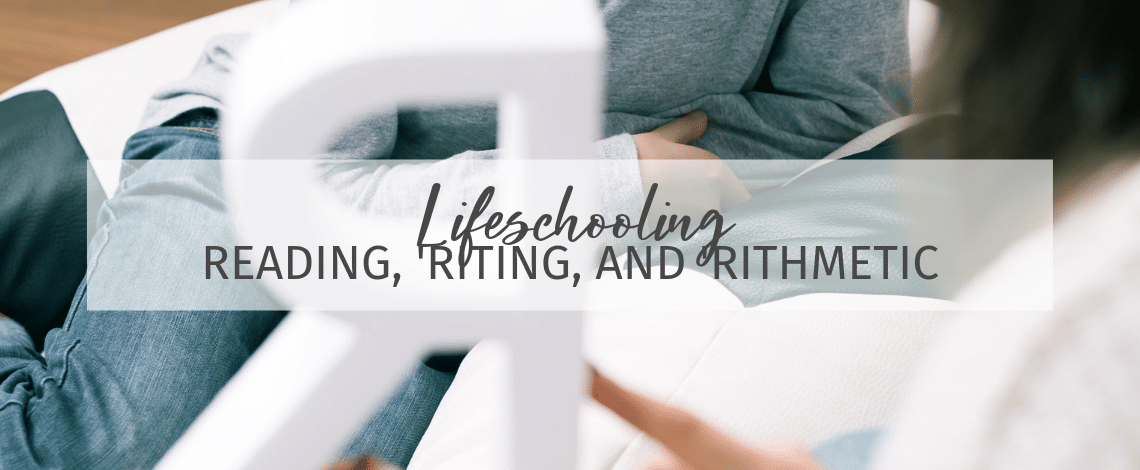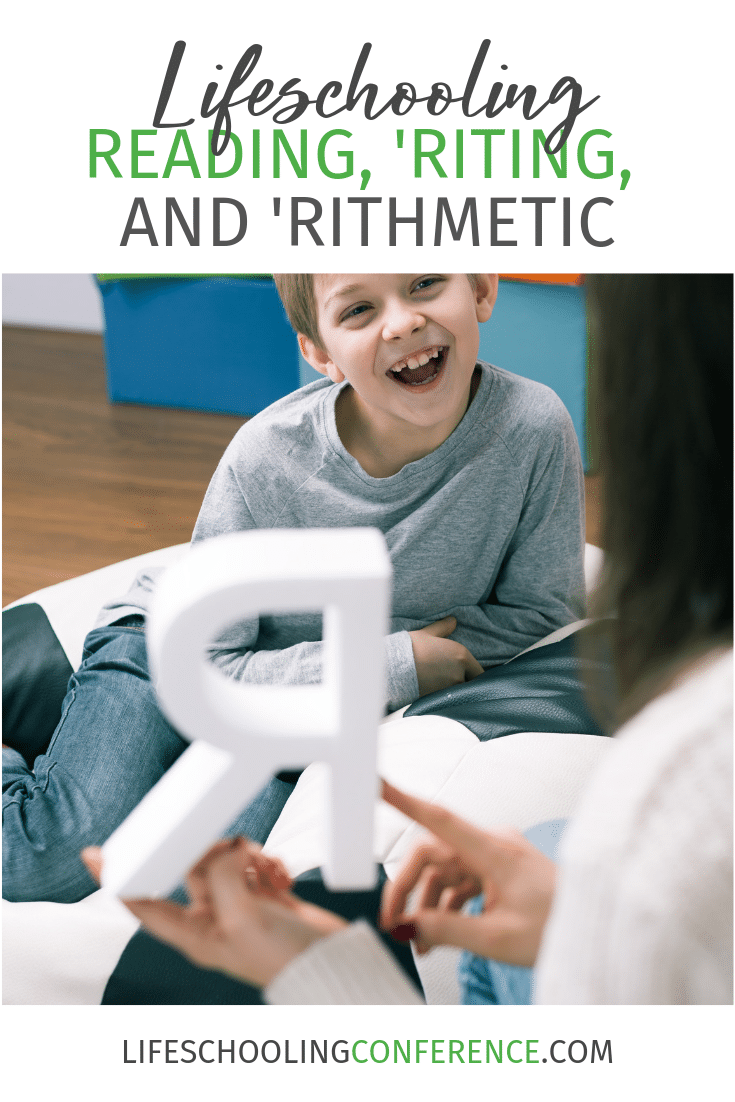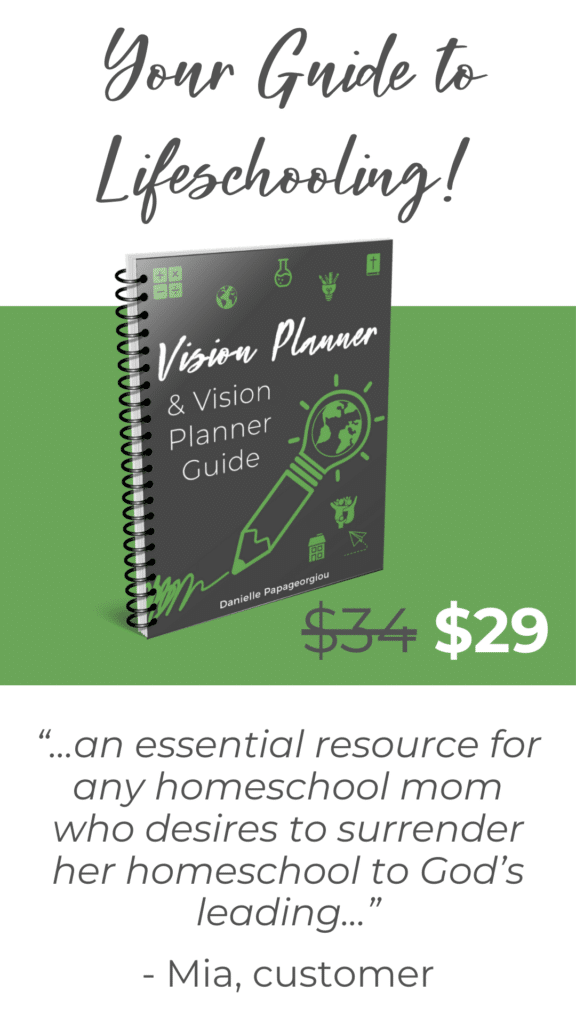Lifeschooling Reading, ‘Riting, and ‘Rithmetic
One of the most frequently asked questions about lifeschooling is: what about the three R’s? How do kids in a relaxed, lifeschooling home learn to read? What about the college essay? Do they learn their math facts? What about high school math?
Lifeschooling reading: A couple of stories of learning to read in my lifeschooling home.
The First One
My four children currently ages 12 to 20, all followed slightly different paths to learning to read. My oldest daughter started identifying and sounding out letters on her own at around age 4. I didn’t know anything about teaching a child to read at that point and we had only just decided to homeschool. All I knew I learned from working at two preschools during my college years.
So, with one eye on her little brother, we used magnetic letter tiles and puzzles to have some fun with words. I bought a colorful drug store workbook, and some Bob Books, and a couple of months before her 5th birthday, she read for real. After that, she learned phonics very quickly through an integrated language arts curriculum, Learning Language Arts Through Literature. I skipped lessons I thought were silly, and by age 6, she was reading Magic Treehouse chapter books.
The Older Boy
Thank the Lord Jesus for those early experiences! My son did not read fluently until he approached his 12th birthday. Being a young homeschooler, I would have blamed myself if not for the experience with my daughter.
Multiple Reading Challenges
He had no interest in letters at age 5, but I thought,
Well, that’s just what you do with Kindergarten children. You teach them to read.
I still wasn’t a lifeschooler at that time but tried to generally practice more relaxed learning in the content areas of science and social studies.
Boy, did we struggle together!
Determined, I tried a different curriculum. No-go. He couldn’t remember anything we did together, stuttered, mixed up the letters as he tried to read and complained that the words moved. We took him to a language specialist who told us that he had a couple of language disorders. We took him to a special optometrist who offered visual therapy for his wandering eyes. Nothing improved his reading. Meanwhile, he began to hate reading.
And God said what?!
I fervently prayed for this boy and God told me to just let him be and stop teaching him to read. So I stopped teaching him to read. I still read books to him. But, we had no reading lessons. And then, amazing things began happening.
After several months, I heard him read. It began with road signs, then grocery store labels. Then, he read comics and instruction manuals.
I cried. My son could read!
And, to compensate for his challenges, I found out that God gave him a photographic memory. This came in handy when he took a college level course in digital art at age 16. Even though he never picked up the textbook, his memory showed him all the classroom presentations and he aced the class. He still prefers audiobooks. Reading still takes a great deal of energy and concentration, but he can read.
God made my son and he knew what he needed. I simply needed to obey and trust. My now adult son knows his own limitations, strengths, and how to use God’s amazing gift to him. Had I persisted, well…..
God made my son and he knew what he needed. I simply needed to obey and trust. Tweet This!Learning ‘rithmetic in my lifeschooling home.
In this post, I mention a schoolteacher in the 1920s who proved that all K-6 math could be taught in one year.
I know, unbelievable, right? But, mathematics is a problem-solving tool, not really a subject. Just like reading, it’s a skill used daily in all kinds of situations and it’s developmentally based. The brain must reach specific milestones to be able to learn math skills.
Elementary Ages
I began to see the truth of this when my older son reached school age, but I didn’t know it when it was time to teach my oldest about numbers. I did know enough to use a manipulatives based math curriculum such as Cuisenaire rods and Making Math Meaningful. But, I eventually abandoned those, too, and just used a variety of books, games, CDRoms, and even a few videos (see a list here.) In the elementary years, I felt the most important things were: learning math facts, telling time, and counting change.
However, the kids’ favorite, was Math Problem of the Day.
I created my own multi-step, real-life math problems and encouraged them to work together to find the answer. They would range from planting a garden and figuring out how many plants to buy to how many gallons of paint were needed for a particular room to planning a party, and how much food to buy with a particular budget. They actually begged me for these!
Middle School and High School
In addition, all of them received an allowance from age 8 to age 13 and they were encouraged to earn more. To do this, most of my kids also sold homemade products several years in a row at a kids’ Christmas craft fair. They also made and sold candy to the neighbors. When they reached middle school age, I went through Steve Slavin’s All the Math You’ll Ever Need to hone up any lacking skills before starting high school. I also used Family Math: the Middle School Years as a resource for pre-algebra skills.
When they reached high school, we discussed career goals and what kind of math education they might need. That aside, all of my children are required to learn personal finance. I think it goes without saying that education in budgeting, investing, insurance, and the like is vital.
Career-wise, though, my oldest two opted not to go to a traditional 4-year university and instead, decided that certificate programs suited them better. With skills and passion in computers and the arts, this made sense and we chose high school math accordingly. We did use textbooks and video instruction for those classes.
Lifeschooling ‘riting
I have found that learning how to write well greatly depends on what is modeled for them in the media they see and hear.
My children all naturally wanted to tell stories and I simply provided paper and pretty bound notebooks. Once they learned to read, I never used a writing curriculum. I encouraged them to type their stories and share their thoughts and knowledge. My youngest son is currently writing an epic story along the lines of Redwall. The younger daughter has created several interactive storybooks about fairies, unicorns, and obscure islands since age 9. My oldest daughter wrote an 80-page novella at the age of 14. And, my oldest son is currently creating a graphic version of a fantasy concept he’s been developing for several years.
Lifeschooling writing is fairly easy. Opportunities for real-life writing are everywhere.
To read more about lifeschooling reading, writing, and arithmetic as well as how to handle different ages, I’m offering you a FREE chapter of my book, God Schooling: How God Intended Children to Learn. Click here to get yours.
- Have a late reader? Don’t lose heart. - September 18, 2020
- A Route 66 Vacation for a Fun Trip Through History - July 12, 2020
- Lessons From Our Animal Adventures - October 14, 2019





One Comment
Good for you, it seems you have an abundance of common sense, somswthing I think is lacking in every aspect of our lives these days.